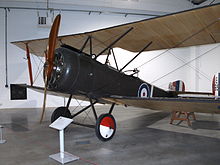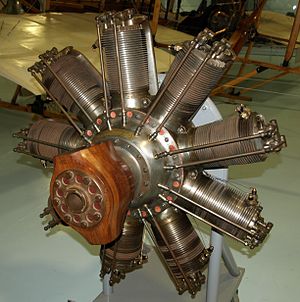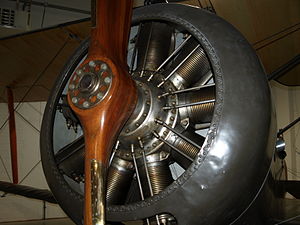- Clerget 9B
-
9B Preserved Clerget 9B engine on display at the Fleet Air Arm Museum, RNAS Yeovilton. Type Rotary engine National origin France Manufacturer Clerget-Blin First run 1913 Major applications Sopwith Camel Number built 3,650 (British production) Unit cost £907.50 (1915)[1] Developed into Bentley BR1 The Clerget 9B was a nine-cylinder rotary aircraft engine of the World War I era designed by Pierre Clerget. Manufactured in both Great Britain (Gwynne Limited) and France, it was used on such aircraft as the Sopwith Camel. The Clerget 9Bf was an increased stroke version.[2]
Contents
Variants
- Clerget 9B
(1913) 130 hp (97 kW). 1,300 produced by Ruston Proctor & Co Ltd of Lincoln
- Clerget 9Bf
(1915) 140 hp (104 kW). Extended stroke (172 mm (6.75 in)) version, increasing capacity to 17.5 L (1,066.5 cu in). 1,750 produced by Gwynnes Ltd. and 600 produced by Ruston Proctor.
Applications
Clerget 9B
 Clerget 9B powered Sopwith 1½ Strutter on display at the Royal Air Force Museum London
Clerget 9B powered Sopwith 1½ Strutter on display at the Royal Air Force Museum London
- Armstrong Whitworth F.K.10
- Avro 504
- Avro 531
- Bristol M.1
- Cierva C.6
- Cierva C.8
- Fairey Hamble Baby
- Nieuport 12
- Nieuport 17
- Nieuport Triplane
- Sopwith Baby
- Sopwith Camel
- Sopwith Scooter
- Sopwith Triplane
- Sopwith 1½ Strutter
Clerget 9Bf
Engines on display
- A preserved Clerget 9B engine is on public display at the Fleet Air Arm Museum, RNAS Yeovilton.
- A Clerget 9Bf engine is on display at the Powerhouse Museum, Sydney.[3]
Specifications (Clerget 9B)
Data from Lumsden.[2]
General characteristics
- Type: Nine-cylinder air-cooled rotary engine
- Bore: 120 mm (4.72 in)
- Stroke: 160 mm (6.30 in)
- Displacement: 16.29 L (993.8 cu in)
- Dry weight: 175 kg (385 lb)
Components
- Fuel system: Bloctube carburettor
- Cooling system: Air-cooled
Performance
- Power output: 130 hp (96 kW) at 1,250 rpm
- Compression ratio: 4.56:1
See also
- Related development
- Comparable engines
- Gnome Monosoupape
- Le Rhône 9J
- Related lists
References
Notes
- ^ Gunston 1989, p. 41.
- ^ a b Lumsden 2003, p. 133.
- ^ Powerhouse Museum - Clerget 9Bf Retrieved: 12 November 2010.
Bibliography
- Gunston, Bill. World Encyclopaedia of Aero Engines. Cambridge, England. Patrick Stephens Limited, 1989. ISBN 1-85260-163-9
- Lumsden, Alec. British Piston Engines and their Aircraft. Marlborough, Wiltshire: Airlife Publishing, 2003. ISBN 1-85310-294-6.
Clerget aircraft engines Rotary engines Radial diesel engines 9A · 14F
'H' engines Type Transatlantique
'X' engines 16X
See also: Clerget aircraft engines Lists relating to aviation General Aircraft (manufacturers) · Aircraft engines (manufacturers) · Airlines (defunct) · Airports · Civil authorities · Museums · Registration prefixes · Rotorcraft (manufacturers) · TimelineMilitary Accidents/incidents Records Categories:- Rotary engines
- Aircraft piston engines 1910-1919
- Clerget aircraft engines
Wikimedia Foundation. 2010.


